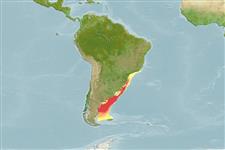Common names from other countries
Environment: milieu / climate zone / depth range / distribution range
Ökologie
seewasser; brackwasser benthopelagisch; tiefenbereich 15 - 82 m (Ref. 127778). Subtropical; 13°S - 53°S, 67°W - 40°W
Southwest Atlantic: Brazil, Argentina, and Uruguay.
Length at first maturity / Size / Gewicht / Alter
Maturity: Lm 29.0 range ? - ? cm
Max length : 60.0 cm TL Männchen/unbestimmt; (Ref. 7392)
Rückenflossenstacheln (insgesamt): 13; Rückenflossenweichstrahlen (insgesamt): 15; Afterflossenstacheln 3; Afterflossenweichstrahlen: 8
Found on the continental shelf in colder waters. Utilized to some degree for human consumption.
Pereiro, S. and A. Vásquez, 1988. Peces marinos III. p. 65-94. In G.B. Cabal, B. Marcheti (eds.) Fauna Argentina: Peces. Centro Editor de América Latina S.A., Junin, Buenos Aires, Brazil, 102 p. (Ref. 7392)
IUCN Rote Liste Status (Ref. 130435)
CITES (Ref. 128078)
Not Evaluated
Bedrohung für Menschen
Harmless
Nutzung durch Menschen
Fischereien: kommerziell
Mehr Information
PartnerBilderStamps, Coins Misc.LauteCiguateraGeschwindigkeitSchwimmstilKiemenoberflächeOtolithsGehirngrößeSehfähigkeit
Tools
Zusatzinformationen
Download XML
Internet Quellen
Estimates based on models
Preferred temperature (Ref.
115969): 4.5 - 16.9, mean 8.1 (based on 170 cells).
Phylogenetic diversity index (Ref.
82804): PD
50 = 0.5005 [Uniqueness, from 0.5 = low to 2.0 = high].
Trophic level (Ref.
69278): 4.0 ±0.71 se; based on food items.
Widerstandsfähigkeit (Ref.
120179): mittel, Verdopplung der Population dauert 1,4 - 4,4 Jahre. (Assuming tm=2-4).
Fishing Vulnerability (Ref.
59153): Moderate vulnerability (44 of 100).
Climate Vulnerability (Ref.
125649): Very high vulnerability (86 of 100).
